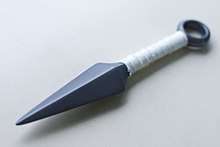Kunai

A kunai (苦無 kunai) is a Japanese tool originally meant for farming in the Tensho Era of Japan (1573–1592). The two widely recognized variations of the kunai are the hand shovel used for turning up crops short kunai (小苦無 shō-kunai) and the big kunai (大苦無 dai-kunai).
Although a basic tool, in the hands of a martial arts expert, the kunai could be used as a multi-functional weapon, popular before the wide spread of firearms. The kunai is commonly associated with the ninja, who used it to gouge holes in walls. By attaching a rope to the ring, the user could easily climb walls or trees, which required great accuracy when thrown. The kunai blade was unsharpened, soft iron and was used for digging, prying, and smashing wood, plaster, and the like—which would have likely destroyed a tool which was sharpened or heat-treated.
Many popular manga and ninjutsu characters use kunai as both their primary and secondary weapons.
The kunai that were used by farmers were a fair bit smaller than the developed kunai that the ninja used. The farming kunai was smaller and there was a small handle with a hole on top. The farmers inserted the index finger into the hole and grabbed the small handle with the other fingers. The kunai that were used by ninjas had a bigger handle to allow them to hold the kunai more efficiently. The hole on the kunai was mainly used for putting a string or a rope so that the ninja could hang it by their belt.
Design
The kunai was conventionally wrought in lengths ranging from 20 cm to 30 cm. It was used by peasants as a multi-purpose gardening tool and by workers of stone and masonry. The kunai is akin to a crowbar. The blade is made of soft iron, and is left unsharpened because the edges are used to smash relatively soft materials such as plaster and wood, for digging holes and for prying. Normally, only the tip is sharpened.
Kunai normally had a leaf-shaped blade and a handle with a ring on the pommel for attaching a rope. The attached rope allows the kunai's handle to be wrapped to function as a grip, or to be strapped to a stick as a makeshift spear; to be tied to the body for concealment; to be used as an anchor or piton, and sometimes to be used as the Chinese Rope Dart. Contrary to popular belief, kunai were not designed to be used primarily as throwing weapons. Instead, kunai were primarily tools and, when used as weapons, were stabbing and thrusting implements.
Varieties of kunai include short, long, narrow-bladed, saw-toothed, and wide-bladed. In some cases, the kunai and the shikoro, a wide-bladed saw with a dagger-type handle, are difficult to distinguish.
Uses
Weapon
Many ninja weapons were adapted from farming tools, not unlike those used by Shaolin monks in China. Since kunai were cheaply produced farming tools of a useful size and weight and could be easily sharpened, they were readily available to be converted into simple weapons. As a weapon, the kunai is larger and heavier than a shuriken and with the grip could also be used in hand to hand combat more readily than a shuriken.
Climbing
In addition, it could be used for climbing, either as a kind of grappling hook or as a piton.
Popular culture
As with ninjutsu, the exaggeration persistent in ninja myths played a large role in creating the popular culture image of kunai. In fictional depictions of ninjas, the kunai is commonly portrayed as a steel knife that is used for stabbing or particularly throwing, sometimes confusing it with the shuriken.
See also
Further reading
| Wikimedia Commons has media related to Kunai. |
- Hatsumi, Masaaki (22 September 1988). The Grandmaster's Book of Ninja Training. McGraw-Hill Education. ISBN 978-0-8092-4629-8.
- Mol, Serge (2003). Classical Weaponry of Japan: Special Weapons and Tactics of the Martial Arts. Kodansha International. ISBN 978-4-7700-2941-6.
- Turnbull, Stephen (2003). Ninja AD 1460–1650. Osprey Publishing. ISBN 978-1-84176-525-9.